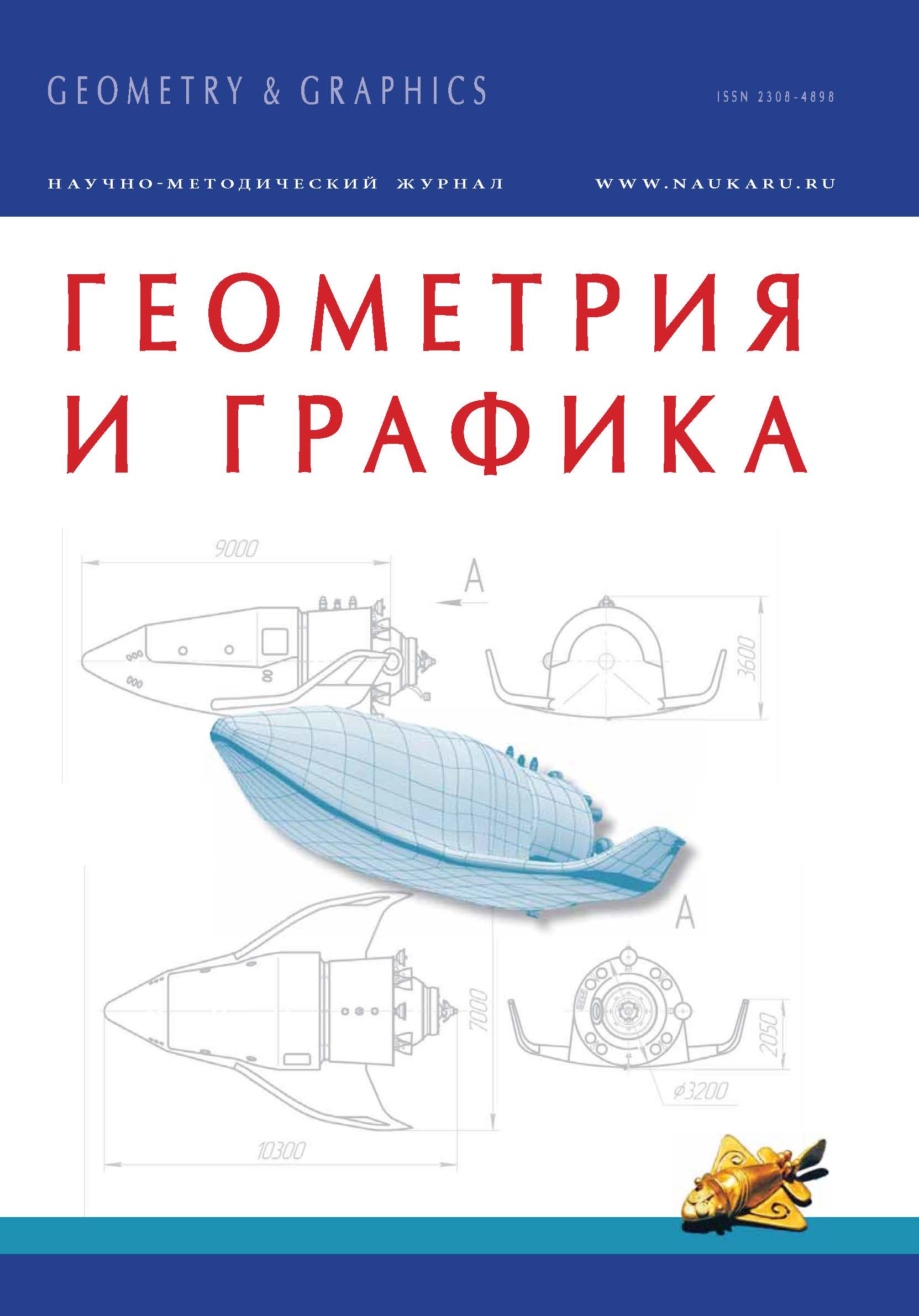Russian Federation
There is a tendency of dividing of the teachers of the engineering graphics departments into three groups: 1) conservatives: we studied the descriptive geometry by textbook of V.O. Gordon, it is supposed to be the textbook for our students; computer graphics must be preceded by "manual" engineering graphics; 2) radicals: the descriptive geometry as an academic discipline has run dry; the training on the basis of 3D modeling is up to date; 3) moderate specialists: descriptive geometry, as a part of the integrated course of engineering geometry, along with engineering and computer graphics, is aimed at providing related branches of mathematics and General engineering disciplines. The article is devoted to justify the positions of specialists. The transformation of the traditional course of descriptive geometry in the engineering geometry can be provided in case of: • considering jointly the synthetics and analytical methods to solve geometric problems, • improving the subject of the course with the forms of the multidimensional space. Theoretical basis of this approach is the principle of duality in multidimensional projective space. It is shown on a geometric interpretation of the solution of a system of n linear equations with n unknowns. The interrelation of synthetic and analytical methods is shown on the examples of setting linear forms of four-dimensional space (point A, straight line a, 2-plane α2 (ABC), 3-plane α3 (ABCD)) general provisions, projecting figures and the solutions of position tasks on the affiliation and the intersection shown. Noted that any positional problem is reduced to solving p + 1 linear systems of n equations with n unknowns, where P is the dimension of the desired p-plane αp. Therefore, following the principle of learning from simple to complex, methodologically correctly consistently explain the algorithms of constructing of a point, line, ..., p-plane. This approach becomes mandatory for entry • from linear to nonlinear forms; • from the solution of educational problems involving simple lines and surfaces to the solution of applied problems involving compound curves and surfaces (one-dimensional, two-dimensional and multidimensional contours); • to the solution of optimization problems methods of geometric programming.
descriptive geometry, synthetic and analytical methods of solving geometric problems, dimension, the degree of freedom, the principle of duality in multidimensional projective space.
1. Borovikov I.F., Ivanov G.S., Surkova N.G. Nauchno-metodicheskie voprosy prepodavanija temy «Pozicionnye zadachi» v kurse nachertatel´noj geometrii [Scientific-methodical problems of teaching of the topic "Positional problem" in the course of descriptive geometry]. Perspektivy razvitija nauki [Prospects of development of science]. Ufa, RITS Bashgu Publ., 2014, pp. 32-40. (in Russian).
2. Voloshinov D.V. O perspektivah razvitija geometrii i ee instrumentarija [About the prospects of geometry and its instrumentation]. Geometrija i grafika [Geometry and graphics], 2012, V. 1, I. 1, pp. 15-21. DOI:https://doi.org/10.12737/3844 (in Russian).
3. Vyshnepol´skij V.I., Sal´kov N.A. Celi i metody obuchenija graficheskim disciplinam [Objectives and methods of learning graphic disciplines]. Geometrija i grafika [Geometry and graphics]. 2013, V. 1, I. 2, pp. 8-9. DOI:https://doi.org/10.12737/777. (in Russian).
4. Gordon V.O., Semencov-Ogievskij M.A. Kurs nachertatel´noj geometrii [A course in descriptive geometry]. Moscow, Vysshaja shkola Publ., 2000.
5. Guznenkov V.N. Geometro-graficheskoe obrazovanie v tehnicheskom universitete [Geometric-graphic education at the technical University]. Moscow, Alma mater (Vestnik vysshej shkoly Publ.), 2014, I. 10, pp. 71-75. (in Russian).
6. Guznenkov V.N., Jakunin V.I. Geometro-graficheskaja podgotovka kak integrirujushhij faktor obrazovatel´nogo processa [Geometro-graphic training as an integrating factor of educational process]. Obrazovanie i obshhestvo [Education and society]. Moscow, 2014, I. 2, pp. 26-28. (in Russian).
7. Ivanov G.S. Kompetentnostnyj podhod k soderzhaniju kursa nachertatel´noj geometrii [Competence approach to the content of the course of descriptive geometry]. Geometrija i grafika [Geometry and graphics], 2013, V. 1, I. 2, pp. 3-5. DOI:https://doi.org/10.12737/775. (in Russian).
8. Ivanov G.S. Perspektivy nachertatel´noj geometrii kak uchebnoj discipliny [Prospects descriptive geometry as an academic discipline]. Geometrija i grafika [Geometry and graphics], 2013, V. 1, I. 1, pp. 26-27. (in Russian).
9. Ivanov G.S. Teoreticheskie osnovy nachertatel´noj geometrii [Theoretical foundations of descriptive geometry]. Moscow, Mashinostroenie Publ., 1988 (in Russian).
10. Ivanov G.S., Dmitrieva I.M. O zadachah nachertatel´noj geometrii s mnimymi reshenijami [About the tasks of descriptive geometry with imaginary solutions]. Geometrija i grafika [Geometry and graphics], 2015, V. 3, I. 2, pp. 3-8. DOI:https://doi.org/10.12737/12163. (in Russian).
11. Korotkij V.A., Hmarova L.I. Nachertatel´naja geometrija na jekrane komp´jutera [Descriptive geometry on the computer screen]. Geometrija i grafika [Geometry and graphics], 2013, V. 1, I. 1, pp. 32-34. (in Russian).
12. Seregin V.I., Ivanov G.S., Dmitrieva I.M., Murav´ev K.A. Mezhdisciplinarnye svjazi nachertatel´noj geometrii i smezhnyh razdelov vysshej matematiki [Interdisciplinary connections of descriptive geometry and related sections of higher mathematics]. Geometrija i grafika [Geometry and graphics], 2013, V. 1, I. 3-4, pp. 8-12. DOI:https://doi.org/10.12737/2124. (in Russian).
13. Seregin V.I., Ivanov G.S., Senchenkova L.S., Borovikov I.F. Geometricheskie preobrazovanija v nachertatel´noj geometrii i inzhenernoj grafike [Geometric transformations in descriptive geometry and engineering graphics]. Geometrija i grafika [Geometry and graphics], 2015, V. 1, I. 2, pp. 23-28. DOI:https://doi.org/10.12737/12165 (in Russian).
14. Sokolova L.S. Mnogomernoe prostranstvo i nagljadnaja geometrija v uchebnoj programme po geometricheskoj podgotovke dlja bakalavrov [Multidimensional space and visual geometry in the curriculum of geometric preparation for bachelors]. Geometrija i grafika [Geometry and graphics], 2015, V. 3, I. 1. pp. 40-46. DOI:https://doi.org/10.12737/10457. (in Russian).
15. Sufljaeva N. E. Sovremennye aspekty prepodavanija graficheskih disciplin v tehnicheskih vuzah [Modern aspects of teaching of graphic disciplines in technical universities]. Geometrija i grafika [Geometry and graphics], 2014, V. 2, I. 4, pp. 28-33. DOI:https://doi.org/10.12737/8294 (in Russian).
16. Tihonov-Bugrov D.E. O nekotoryh problemah graficheskoj podgotovki v tehnicheskih vuzah (vzgljad iz Sankt-Peterburga) [About some problems of graphic training in technical universities (the view from St. Petersburg)]. Geometrija i grafika [Geometry and graphics], 2014, V. 2, I. 1, pp. 46-52. DOI:https://doi.org/10.12737/3848. (in Russian).
17. Chetveruhin N.F. Proektivnaja geometrija [Projective geometry]. Moscow, Prosveshhenie Publ., 1969 (in Russian).
18. Chetveruhin N.F., Levickij V.S., Prjanishnikova Z.I., Tevlin A.M., Fedotov G.I. Kurs nachertatel´noj geometrii [A course in descriptive geometry]. Moscow, GITTL Publ., 1956. (in Russian).






